¿Alguna vez has intentado abrir una de tus entradas de WordPress y te ha aparecido un error 404? A veces nos ocurre cuando trabajamos en nuestros propios sitios de WordPress o ayudamos a nuestros usuarios.
Este error se produce cuando puede acceder al área de administración de WordPress y al blog, pero cuando intenta abrir una entrada concreta, aparece el mensaje “404 no encontrado”.
Puede ser frustrante ver que tu contenido desaparece, pero hemos encontrado algunas soluciones para solucionar este problema. En esta guía completa, le mostraremos cómo arreglar las entradas de WordPress que devuelven errores 404.
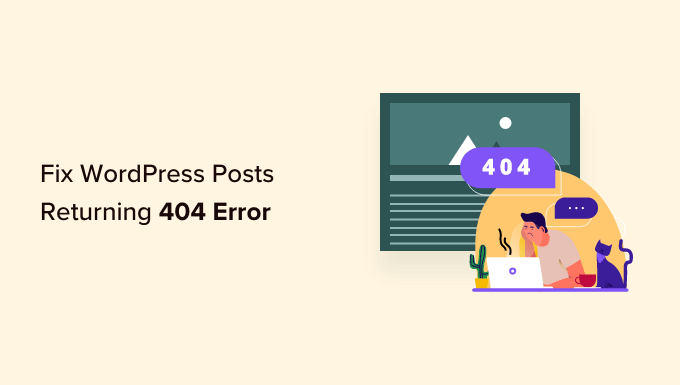
¿Por qué mis entradas de WordPress devuelven un error 404?
Hay varias razones por las que sus entradas pueden mostrar un error 404 “Página no encontrada” en WordPress. Estos pueden incluir:
- Conflictos de plugins o temas: A veces, los plugins o temas que has instalado en tu sitio pueden interferir con la forma en que WordPress gestiona los permalinks. Esto puede provocar enlaces rotos y errores 404.
- Problemas de código personalizado: Si has añadido código personalizado a tu sitio web, puede haber errores en el código que estén afectando a los permalinks o causando otros conflictos, dando lugar a errores 404 para tus entradas.
- Problemas con su archivo .htaccess: El archivo .htaccess juega un papel importante en cómo WordPress estructura las URLs. Si este archivo está dañado o no existe, puede provocar errores 404 en tus entradas o páginas.
Cómo encontrar todas las entradas de WordPress con errores 404
Antes de llegar a las soluciones, sería bueno averiguar si este error sólo está ocurriendo en uno o dos puestos o en varios. De esta forma, podrás determinar el alcance del problema y elegir la solución más adecuada.
Una forma sencilla de averiguarlo es utilizar Google Search Console. Si aún no has enviado tu sitio a Google Search Console, lee nuestra guía sobre cómo añadir tu sitio WordPress a Google Search Console.
Una vez que el robot de Google haya rastreado e indexado su sitio, Google Search Console le proporcionará información detallada sobre el rendimiento de su sitio, incluidos los errores 404 que encuentre.
Para saber qué entradas están devolviendo errores 404, puedes acceder al panel de control de Search Console. A continuación, ve al informe “Páginas” y verás una lista detallada de todos los errores.
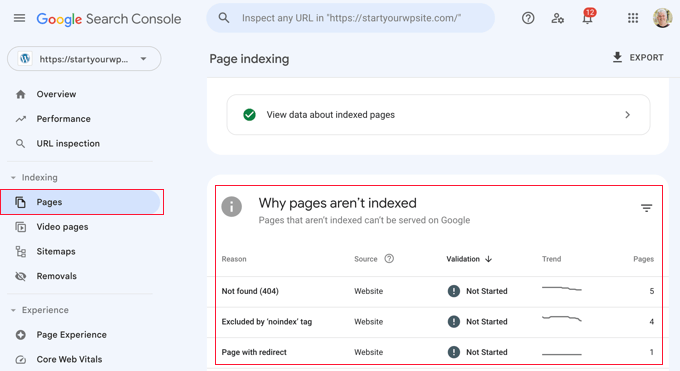
Para obtener más información, puede leer nuestra lista de consejos para utilizar Google Search Console con el fin de aumentar el tráfico del sitio web, que incluye algunos consejos sobre cómo solucionar errores 404 con la herramienta.
Dicho esto, veamos cómo corregir las entradas de WordPress que devuelven errores 404. Puede utilizar los siguientes enlaces para ir directamente a las diferentes soluciones:
¿No tiene tiempo para arreglar los errores 404 usted mismo? ¡WPBeginner Pro Services puede ayudarte! Con nuestro asequible Soporte WordPress de Emergencia, puedes contratar expertos para arreglar errores 404, enlaces rotos, problemas de redireccionamiento y mucho más. Deje de estresarse por los problemas de WordPress y ¡arréglelos! ¡Programe un Servicio de Soporte WordPress de Emergencia hoy mismo!
Método 1: Comprobar si hay conflictos de plugins o temas y problemas de código personalizado
A veces, los plugins, temas o código personalizado que has añadido a tu sitio web de WordPress pueden interferir con los enlaces permanentes o causar conflictos, dando lugar a errores 404. Incluso lo hemos experimentado nosotros mismos cuando probamos herramientas en nuestro sitio de demostración.
Una forma de resolver este problema es desactivar temporalmente los plugins. Los plugins a veces pueden alterar la forma en que WordPress gestiona los enlaces.
Una vez que hayas desactivado los plugins, puedes reactivarlos uno a uno mientras compruebas si el error 404 reaparece después de activar cada plugin. Si el error aparece después de activar un plugin específico, ese podría ser el culpable.
A continuación, puedes hacer una búsqueda rápida en Google de soluciones relacionadas con ese plugin o ponerte en contacto con el desarrollador del plugin para obtener asistencia.
Del mismo modo, su tema de WordPress podría estar causando el conflicto.
Para comprobarlo, puedes cambiar temporalmente a un tema predeterminado de WordPress como Twenty Twenty-Three o Twenty Twenty-Four. Solo tienes que ir a Apariencia “ Temas y hacer clic en “Activar” en un tema predeterminado.

Si el error 404 desaparece con el tema predeterminado, indica un posible conflicto con su tema actual. A continuación, puedes intentar solucionar el problema con el tema o considerar la posibilidad de utilizar un tema diferente.
Puede consultar nuestra selección de expertos de los temas de WordPress más populares para obtener recomendaciones.
Si ha insertado recientemente fragmentos de código en su sitio web, es posible que haya errores en el código que causen los errores 404. Examina detenidamente el código que has añadido y comprueba si puedes identificar algún error.
La forma más segura de añadir fragmentos de código a WordPress es con el plugin WPCode. Este plugin te permite insertar código personalizado sin trabajar directamente con los archivos del tema, lo que reduce el riesgo de romper tu sitio web.
Además, siempre que WPCode detecte un error en tu código, desactivará automáticamente el fragmento y te pedirá que lo compruebes. También puedes utilizar el modo de prueba para comprobar si tu código funciona antes de enviarlo a tu sitio web.
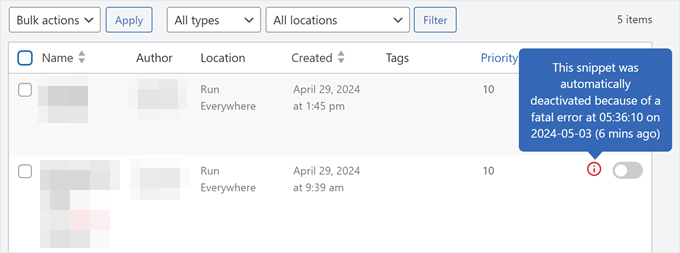
Si ninguna de estas soluciones funciona, pasa al siguiente método en el que solucionaremos los problemas de configuración de tu enlace permanente.
Método 2: Corregir la configuración de Permalink
Las entradas de WordPress pueden devolver errores 404 debido a problemas con las reglas de reescritura en su archivo .htaccess. En la mayoría de los casos, puede corregir el problema actualizando sus ajustes de enlaces permanentes.
Simplemente vaya a Ajustes ” Enlaces permanentes en el administrador de WordPress y haga clic en el botón “Guardar cambios”.
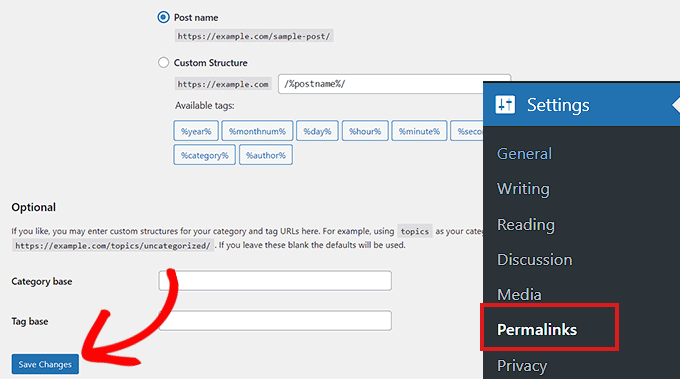
No es necesario realizar cambios en los ajustes de los enlaces permanentes. Esto actualizará los ajustes de enlaces permanentes y eliminará las reglas de reescritura.
En la mayoría de los casos, esta solución corrige el error 404 de las entradas de WordPress. Sin embargo, si no le funciona, probablemente necesite actualizar su archivo .htaccess manualmente.
Método 3: Actualizar el archivo .htaccess de WordPress
Antes de empezar, asegúrese de hacer una copia de seguridad de su archivo .htaccess de WordPress. Si algo va mal, puede restaurar fácilmente el archivo original.
Ahora, tendrá que conectarse a su servidor utilizando un cliente FTP como FileZilla o la aplicación Administrador de Archivos en el escritorio de alojamiento de WordPress.
A continuación, tendrá que encontrar y editar el archivo .htaccess, que se encuentra en la misma ubicación que carpetas como /wp-content/ y /wp-includes/.
Basta con hacer clic con el botón derecho en el archivo y seleccionar “Permisos de archivo”.
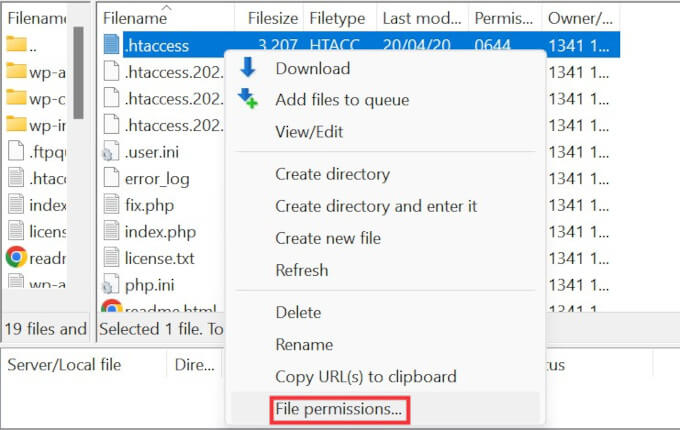
Puede hacer que el archivo sea de escritura cambiando sus permisos a 666.
Basta con introducir “666” en la casilla “Valor numérico” y hacer clic en “Aceptar”.
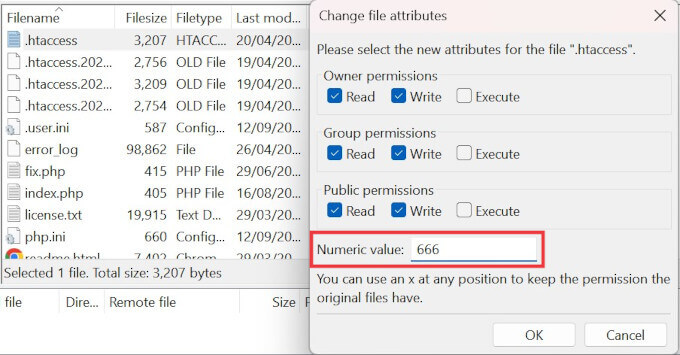
A continuación, debe repetir los pasos del primer método de nuestro tutorial. Una vez hecho esto, no te olvides de cambiar los permisos de nuevo a 660.
También puede editar el archivo y añadirle código.
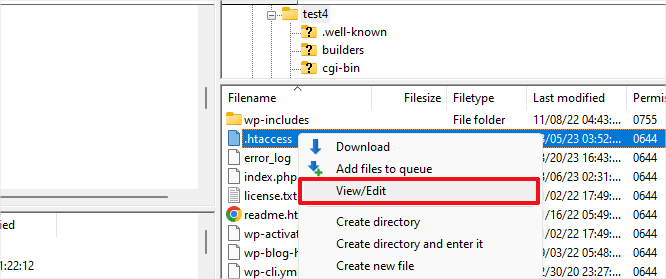
Una vez que haya abierto el archivo .htaccess con un editor de texto, simplemente inserte este código:
1 2 3 4 5 6 7 8 9 10 | # BEGIN WordPress<IfModule mod_rewrite.c>RewriteEngine OnRewriteBase /RewriteRule ^index\.php$ - [L]RewriteCond %{REQUEST_FILENAME} !-fRewriteCond %{REQUEST_FILENAME} !-dRewriteRule . /index.php [L]</IfModule># END WordPress |
Método 4: Póngase en contacto con su proveedor de alojamiento
Si ninguna de las soluciones anteriores ha corregido el error 404 de las entradas de WordPress, le recomendamos que se ponga en contacto con su proveedor de alojamiento de WordPress. Es posible que haya un error por su parte o que puedan ayudarte a diagnosticar el problema.
Consulte también nuestra guía sobre cómo solicitar soporte de WordPress correctamente y obtenerlo.
Método 5: Activar mod-rewrite (Instalación local de WordPress)
Si está utilizando un servidor local para realizar pruebas, deberá activar mod_rewrite en la configuración de Apache de su sitio MAMP, WAMP o XAMPP.
Esto permitirá a WordPress generar URLs limpias y evitar el error 404 para entradas y páginas en su servidor local.
La forma de hacerlo dependerá de la plataforma que utilices. Las personas que utilizan XAMPP pueden abrir su panel de control y hacer clic en el botón ‘Config’ dentro de Acciones. Luego, selecciona ‘Apache (httpd.conf)’.
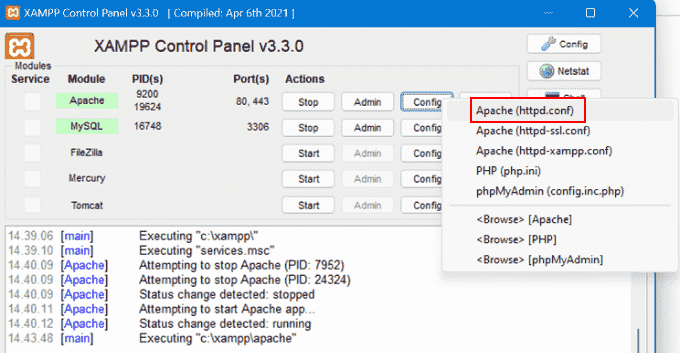
A continuación, tendrá que encontrar esta línea #LoadModule rewrite_module modules/mod_rewrite.so y quitar el ‘#’ para descomentarla.
Esto cargará el mod_rewrite.
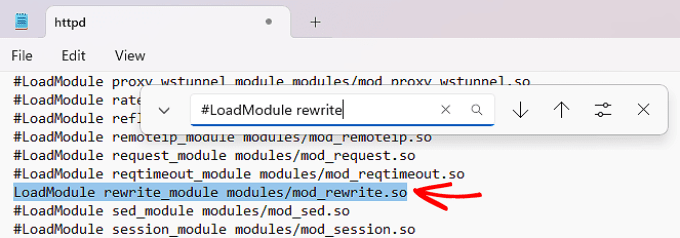
A continuación, busque todas las instancias de AllowOverride None y cámbielas a AllowOverride All.
El valor “Todas” significa que se pueden anular todas las directivas.
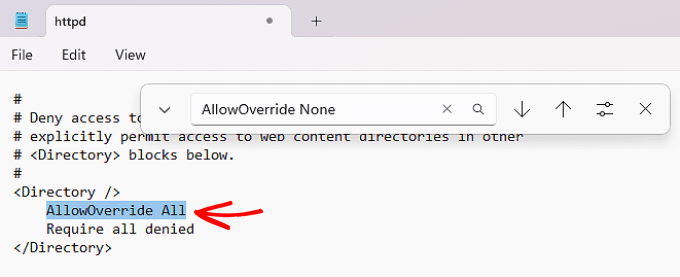
Una vez hecho esto, puedes guardar el archivo httpd.conf y cerrarlo. Después, en el panel de control de XAMPP, haz clic en ‘Detener’ en el módulo Apache y en ‘Iniciar’ de nuevo para reiniciarlo.
A continuación, vuelva a su panel de administrador para ver si sus enlaces permanentes están trabajando.
Tutorial en vídeo
Si necesita instrucciones visuales, no tiene más que ver el siguiente vídeo.
Esperamos que este artículo te haya ayudado a resolver los errores 404 en las entradas de WordPress. Es posible que también desee ver nuestra guía de los errores más comunes de WordPress y cómo solucionarlos, junto con nuestras selecciones de expertos para los mejores plugins de WordPress para hacer crecer su sitio.
If you liked this article, then please subscribe to our YouTube Channel for WordPress video tutorials. You can also find us on Twitter and Facebook.





taher
My problem is a little different i do have access to my wp-admin, But i am unable to access to any page within wordpress, including dashboard or settings and re-directed to 404-error page. I have disabled cloudfare, but the problem persists.
WPBeginner Support
If the method in this article is not working you may want to try the general troubleshooting steps in:
https://www.wpbeginner.com/beginners-guide/beginners-guide-to-troubleshooting-wordpress-errors-step-by-step/
to see if it is due to a specific plugin or theme.
Admin
sikkandhar
great help, by just changing theme of wordpress, my 404 errors solved,
thank you for simple and great idea.
WPBeginner Support
Glad our guide could help
Admin
Oswaldo
Thanks for this amazing solution. I have a membership site and when i looked up to my mail this morning i have a lot of users that wrote that the cant access to the page because is showing the 404 error message and in fact this was happening, i didint know what to do, i thought it was some plugin or some function i put the night before….
Then i found this post, i saved again the permalinks as shown in this post and WORKED!!!
but i am not happy yet, i want to know why happened this problem? so this wont repeat again because all night while i was sleeping this problem happened
because all night while i was sleeping this problem happened 
please can you tell us, why happened this problem, so we can avoid this?
Thank you
WPBeginner Support
Sadly, it is difficult to say the root cause. It could have been an update from the host’s end or something on your site could have updated your permalinks incorrectly as some possibilities.
Admin
Lina Jin
I checked .htaccess and permalink settings too but its still not working.
In pages, I can see only some pages and others show errors.
‘Trying to get property ‘post_author of non-object in C:\xampp\htdocs\aaa\wp-admin\incldues\class-wp-posts-list-table.php on lline 1180’
So the page links are not working and after login, the homepage is automatically redirected to wp-admin and dashboard shows nothing.
Can you help me with this?
WPBeginner Support
You would want to start with the general troubleshooting steps in: https://www.wpbeginner.com/beginners-guide/beginners-guide-to-troubleshooting-wordpress-errors-step-by-step/
You could also try updating your WordPress files using the method in: https://www.wpbeginner.com/wp-tutorials/how-to-manually-update-wordpress-using-ftp/
Admin
Harry
Thank you for this tutorial, solved my problem.
WPBeginner Support
Glad our article could help
Admin
kaleab
i had the same problem geting 404 error in post.php …it was frustrating but the only thing worked form me was change the the theme..and change it again…it worked for me………..
WPBeginner Support
Thanks for sharing what worked for you
Admin
TrigienIT
i had the same issue. tried the options above but they did not work until I also changed the theme to another, then reverted back to the normal theme.
José
None of the solutions worked for me. I can only acces to my home page, any other link like pages & post are not working. The update that caused this was the 5.0.3
WPBeginner Support
To ensure this is not a conflict with a theme or plugin you would want to take a look at this article for steps to try: https://www.wpbeginner.com/beginners-guide/beginners-guide-to-troubleshooting-wordpress-errors-step-by-step/
Admin
Nikki S
Wheew! This DID work for me. All I had to do was hit the Save button. So thankful for the article.
I just updated to WP 5.0.2 yesterday from 4.9.8. Could that have been the cause? It seems to run fine yesterday.
WPBeginner Support
As with any technology, there are many possible reasons. It could have been the update, a hiccup with the host, or another unknown reason.
Admin
Anjalai
am working in wordpress admin suddendly it showing 404 error message. so what am to do and i am beginner for wordpress
WPBeginner Support
You would want to follow the steps in this article and should none of them work, reach out to your hosting provider and they should be able to assist.
Admin
Okan
Thanks thanks thanks. You are the man!
Mike
Thank you so much. It worked. My site is fully back online. Thank you.
WPBeginner Support
Glad you found it helpful
Admin
RKapunan
Thank you so much. My links are back!
Jennifer Nelson
Thank you!!!!
Daniel S
I have tried all the suggestions from the article and some from comments.
Then I contacted my hosting company and it turned up that their ModSecurity module on the server blocked POST requests with “+src=” string in it.
It could be different rule for you but if everything else fails try asking your hosting company to check if any request was blocked at the server level.
zak
thank you so much you are amazing, i love you so much, you are great, i searched a lot of pages and no one knows and teaches like you. you are awesome.
Thank you Thank you Thank you
Matzi
Thank you. It worked perfectly.
jay
this is happening to our site almost monthly and the only way to fix is to reset the permalinks in wp dashboard. debug log file is clean so i dont have any clue where to start fixing. any one having the same problem?
Ronny
I have the same problem! but I do not know where the problem comes from? does anyone know how to solve it?
Musab
Thaaanks many thanks
Arlene
My world was torn apart when I received this 404 error. Thank you WPBeginner for this helpful guide.
Jerry Bordadora
Thank you!! You save my me bro
Toyin
My issue has to do with the next page. I reduced the number of posts showing on my home page from 10 to 5, and when I click on the next page, it’s coming up with the 404 page not found
Aram
Hello! Thank You for interesting article! I have a little different problem. I want to redirect my 404 page to another, accurate and beautiful page. And normaly use plugins or template possibilities for that. But one of my sites, where there is the same template that I usually work with, the 404 page does not exist at all. Whatever I do. I get error telling that The requested document was not found on this server.
WPBeginner Support
Hi Aram,
Try updating your permalink structure. Simply visit Settings » Permalinks and then click on the save changes button without changing anything.
Admin
Ann-Jeanette
I cannot put in words how grateful I am for this exact article. THANK YOU
behdad
extremely helpful thanks
Renan
Works like a charm!
Morcio
It works, thanks THAAANKS a lot!!
Zihad
Thanks for such an easy solution.
Okereke Divine
This article is actually very very helpful.
But my problem seems to be different. Please WPBEGINNER, you guys should please and please help me…
I have tried the methods above but its not working. though my problem is kindoff different.
My problem is:
Sometimes, When I try to update my previous post or make a new post.., it redirects me to “404 error. Please and please help me.
WPBeginner Support
Hi Okereke,
Please try these steps. Go to Settings > Writing page and under the update services section delete any URLs in the box (Normally you will only see one URL rpc.pingomatic.com). Now click on the Save changes button to store your settings.
Try editing a post to see if this resolved your issue. If it didn’t then, please try steps in our WordPress troubleshooting guide.
Admin
Lisa Cox
This article saved me so much time….I was ready to scrap the whole thing and re-do the blog from the start because I thought I had made an irreversible mistake. Two clicks everything is fixed – THANK YOU! Sorry, I didn’t mean to sound like Dr. Suess. Enjoy your day!
Daulat khan
Hi! This article was helpful but when i put my site on google search bar ex, ac-universal.com/wp-admin an error 404 found how can i enter into my word press.
Guied ne thanks
WPBeginner Support
Hi Daulat Khan,
Have you tried the .htaccess method described in the article?
Admin
Mark Wayda
Just wanted to say thanks. Simple and effective fix for a problem that had been perplexing me for a few days!
joseph
thank you, this was very helpful
Khulu
Thank you Tom
Your solution works perfectly!!!!
Ash
Thanks. Your instructions worked 100%. It was driving me crazy.
Okereke Divine
Though my problem was that if i try to update my post., it redirects me to 404page.
I followed your instructions and it worked perfectly!
Collins
I can’t access my home page.
It keep saying 404 not found whenever i go to my url
Fernando Njaria
Thank you so much, had me going crazy with the 404 error, but after saving changes to the permalinks settings it worked!
Ibrahim Shabbir
I Cannot Even Access My Admin Page
Doni
That is my problem also. I can access my home page and one of the two top-nav pages, but I can’t access the second page, and I can’t get to /wp-login or /wp-admin.
Paulo
Awesome… saved my life, thank you
Tom
Great tips – for some reason, this didn’t completely fix my issue as AllowOverride was set to ‘None’ in my httpd.conf file
Should anybody else run into the issues, simply edit your Apache2 httpd.conf file located in one of these locations: /etc/apache2/httpd.conf. /etc/apache2/apache2.conf.
Look for:
Options Indexes FollowSymLinks
AllowOverride None
Require all granted
And replace with:
Options Indexes FollowSymLinks
AllowOverride All
Require all granted
Hope this helps somebody!
Clinton
Thank you Tom,
I deployed a new site with Google One Click Deploy and missed some instructions about setting the AllowOverride All for the docroot directory. Your reply along with this article helped me get this working again. With AllowOverride set to None .htaccess files are ignored, so the directives to use make permalinks work, fail. In my case the config that I needed to edit was /etc/apache2/sites-available/wordpress.conf which had the directory of the wordpress install with the AllowOverride None set.
My Real Name
Thank you sir. You are my hero right now. I looked at so many sites and not a single one of them mentioned this. It wasn’t even obvious from the apache manual, to the extent that I read that.
Dipak Vasava
Thank You very, problem solved. its working code.
Simran
Thanks a lot..nothing to say. It really helped me. You done a great work..Thank you so much
Lagz
Worked like a charm, Thanks!
Contact form 7 Ajax was not working, giving me the feedback 404 error in console log.
I did not suspect rewriting rules until I read this.
Saving the permalink settings did the job!
Thank you
Favour
am confused, at the .htacess what I saw there was 0644 not 660, how do I go about it.
JP
Thank you for posting this- it saved me a ton of time- Cheers!
prabhat pandit
very helpful information for me
Richard
Thank you very much!!
Prabhat
thank you very much. for a moment i felt all my work is gone. you saved me
Sonja
Thank you!!! This was an awesome guide. Made my evening a lot better!
eriab nsereko
Thx WPB team, it worked like charm and that’s why I really love this mighty site!